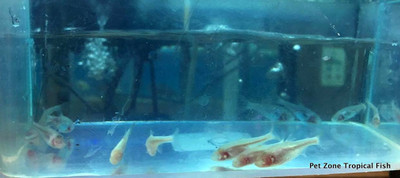Mexican Tetra
Posted by Max Gandara on on 15th Jan 2025
Unveiling the Mysteries of the Blind Cave Tetra
The world beneath the surface of our planet holds countless wonders, and among them is the fascinating Blind Cave Tetra. This unique species of fish, which has adapted to life in the perpetual darkness of caves, offers a captivating glimpse into the power of evolution and adaptation. Let’s dive into the world of the Blind Cave Tetra and explore what makes this fish so extraordinary.
Meet the Blind Cave Tetra
The Blind Cave Tetra, scientifically known as Astyanax mexicanus, is a small freshwater fish native to the rivers and caves of Mexico. This species has two distinct forms: the surface-dwelling form, which has normal vision, and the cave-dwelling form, which is blind.
Physical Characteristics
The most remarkable feature of the cave-dwelling tetra is its lack of eyes. Over generations, these fish have adapted to the lightless environment by losing their eyes entirely. Instead, they have developed heightened other senses to navigate and survive in the dark. Additionally, their bodies are often a pale, translucent color, a common trait among cave-dwelling creatures.
Adaptations to Darkness
The Blind Cave Tetra's adaptation to life without vision is a testament to the wonders of evolution. With no need for eyes in the dark caves, the fish has developed a keen sense of touch and smell. They possess a lateral line system, a series of sensory organs that detect vibrations and changes in water pressure, allowing them to navigate and locate food with remarkable precision.
The Science Behind the Blindness
The study of the Blind Cave Tetra provides valuable insights into evolutionary biology. Scientists are particularly interested in how and why the fish lost their eyes. Research suggests that maintaining eyes in a lightless environment is metabolically costly with no apparent benefit. Therefore, over time, natural selection favored individuals with reduced eye size, eventually leading to complete loss.
Genetic Insights
Genetic studies have revealed that the eye reduction in Blind Cave Tetras involves changes in multiple genes. These genetic changes not only affect eye development but also contribute to other adaptations, such as enhanced non-visual sensory systems. This makes the species an excellent model for studying genetic and developmental processes in evolution.
Conservation and Importance
While the Blind Cave Tetra is not currently endangered, their unique habitat makes them susceptible to environmental changes. Protecting their cave ecosystems is crucial for their survival. Moreover, these fish are an important part of the scientific community’s efforts to understand evolution and adaptation.
Educational and Research Significance
The Blind Cave Tetra serves as a fascinating subject for educators and researchers alike. Their story of adaptation is not only intriguing but also provides a tangible example of evolutionary principles in action. As such, they are often featured in academic studies and educational programs.
Conclusion
The Blind Cave Tetra is a remarkable example of nature’s ability to adapt and thrive in even the most challenging environments. Their story reminds us of the incredible diversity of life on Earth and the complex processes that drive evolution. By studying these resilient fish, we gain valuable insights into the mechanisms of natural selection, adaptation, and the interconnectedness of life. Whether you're a scientist, a student, or simply a nature enthusiast, the Blind Cave Tetra offers a window into the mysterious and wonderful world of evolutionary biology.

